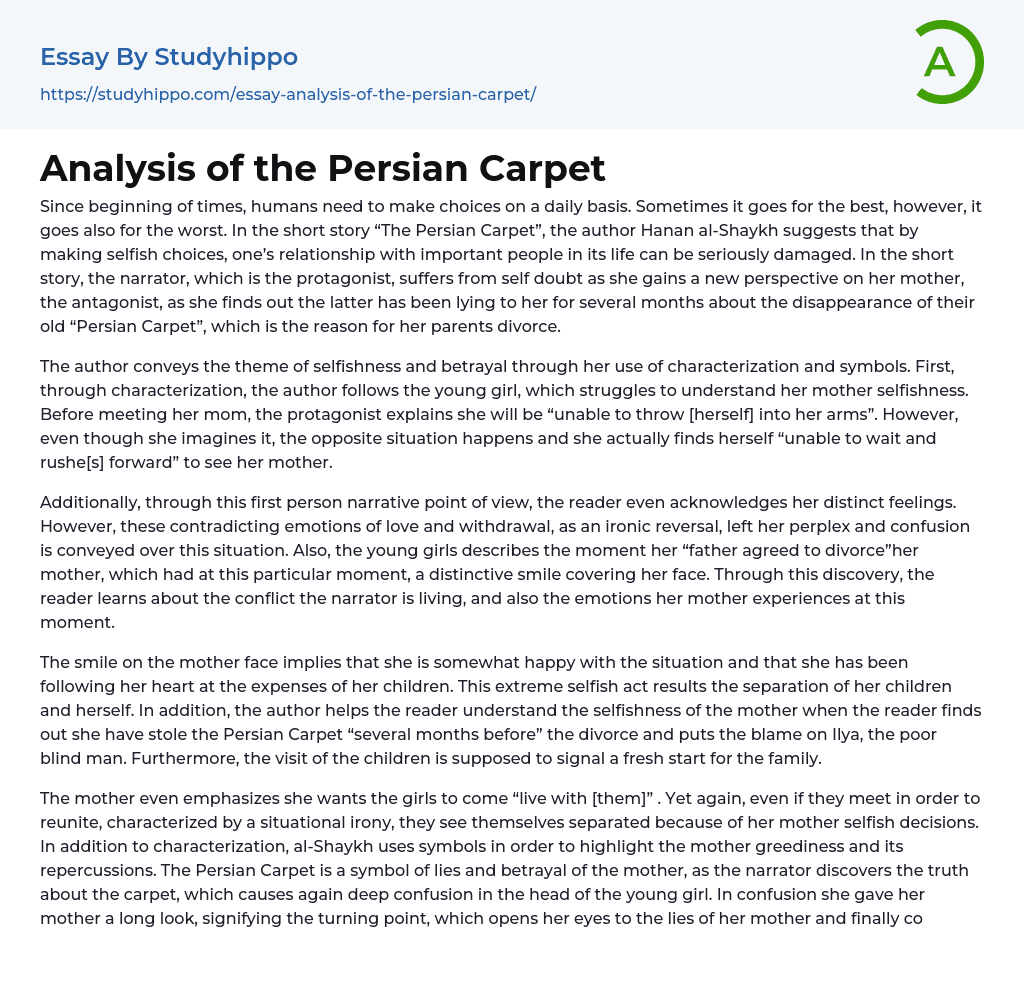Since beginning of times, humans need to make choices on a daily basis. Sometimes it goes for the best, however, it goes also for the worst. In the short story “The Persian Carpet”, the author Hanan al-Shaykh suggests that by making selfish choices, one’s relationship with important people in its life can be seriously damaged. In the short story, the narrator, which is the protagonist, suffers from self doubt as she gains a new perspective on her mother, the antagonist, as she finds out the latter has been lying to her for several months about the disappearance of their old “Persian Carpet”, which is the reason for her parents divorce.
The author conveys the theme of selfishness and betrayal through her use of characterization and symbols. First, through characterization, the author follows the young girl, which struggles to understand her
...mother selfishness. Before meeting her mom, the protagonist explains she will be “unable to throw [herself] into her arms”. However, even though she imagines it, the opposite situation happens and she actually finds herself “unable to wait and rushe[s] forward” to see her mother.
Additionally, through this first person narrative point of view, the reader even acknowledges her distinct feelings. However, these contradicting emotions of love and withdrawal, as an ironic reversal, left her perplex and confusion is conveyed over this situation. Also, the young girls describes the moment her “father agreed to divorce”her mother, which had at this particular moment, a distinctive smile covering her face. Through this discovery, the reader learns about the conflict the narrator is living, and also the emotions her mother experiences at this moment.
View entire sample
justify;">The smile on the mother face implies that she is somewhat happy with the situation and that she has been following her heart at the expenses of her children. This extreme selfish act results the separation of her children and herself. In addition, the author helps the reader understand the selfishness of the mother when the reader finds out she have stole the Persian Carpet “several months before” the divorce and puts the blame on Ilya, the poor blind man. Furthermore, the visit of the children is supposed to signal a fresh start for the family.
The mother even emphasizes she wants the girls to come “live with [them]” . Yet again, even if they meet in order to reunite, characterized by a situational irony, they see themselves separated because of her mother selfish decisions. In addition to characterization, al-Shaykh uses symbols in order to highlight the mother greediness and its repercussions. The Persian Carpet is a symbol of lies and betrayal of the mother, as the narrator discovers the truth about the carpet, which causes again deep confusion in the head of the young girl. In confusion she gave her mother a long look, signifying the turning point, which opens her eyes to the lies of her mother and finally comprehends that Ilya has been used as a object in their separation. Furthermore, the Carpet is also used as a personification. The author attributes the Persian Carpet a feeling of anger and deception, due to what it signifies, as previously discussed. In addition, a situational irony is also attributed with this symbolic item. Before, for the protagonist, the carpet was associated with a
feeling of “happiness”.
However, the situation turns out differently than it was supposed too and is now associated with a feeling of anger and disappointment. In conclusion, through the short story “The Persian Carpet”, the author suggests that one’s selfish choices can have major negatives impacts on relationships with people of its entourage. Al-Shaykh demonstrates this them through the use of characterization and symbols. The little girl is disappointed and angry when she finds out the shocking truth about her mother.
This circumstance leads her to have a turning point in terms of comprehension of life with a more accurate point of view. Life is surely not always as is expected at the ends of folktales and people are not always who they seem they are. However, we are still living in a world where we uncover the realities by growing up and by standing alongside others in our society. Furthermore, as the author underlies it, it is always better to tell the truth, than lie to someone close to you, in order to keep that strong bound.
- Ambition essays
- Anger essays
- Betrayal essays
- Boredom essays
- Confidence essays
- Courage essays
- Desire essays
- Disgrace essays
- Doubt essays
- Empathy essays
- Fairness essays
- Fear essays
- Feeling essays
- Forgiveness essays
- Grief essays
- Guilt essays
- Happiness essays
- Harmony essays
- Hate essays
- Honesty essays
- Honor essays
- Hope essays
- Humanity essays
- Inspiration essays
- Kindness essays
- Laughter essays
- Loneliness essays
- Lost essays
- Loyalty essays
- Need essays
- Passion essays
- Pressure essays
- Pride essays
- Regret essays
- Respect essays
- Responsibility essays
- Sarcasm essays
- Shame essays
- Suffering essays
- Suspense essays
- Tolerance essays
- Allegory essays
- Alliteration essays
- Comedy essays
- Comic book essays
- Drama essays
- Dystopia essays
- Fairy Tale essays
- Fantasy essays
- Fiction essays




